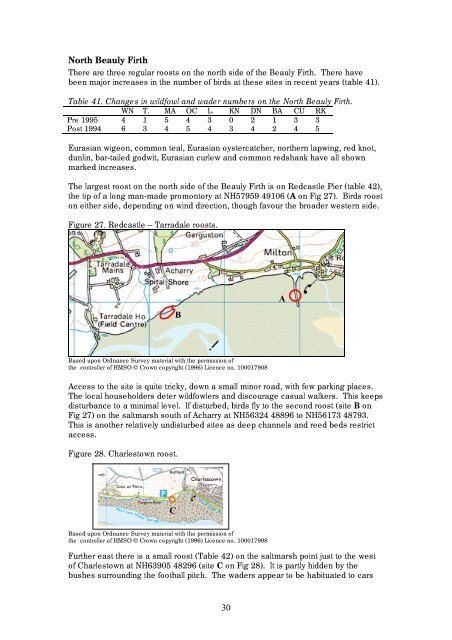Commissioned Report 252 - Scottish Natural Heritage
Commissioned Report 252 - Scottish Natural Heritage
Commissioned Report 252 - Scottish Natural Heritage
You also want an ePaper? Increase the reach of your titles
YUMPU automatically turns print PDFs into web optimized ePapers that Google loves.
North Beauly Firth<br />
There are three regular roosts on the north side of the Beauly Firth. There have<br />
been major increases in the number of birds at these sites in recent years (table 41).<br />
Table 41. Changes in wildfowl and wader numbers on the North Beauly Firth.<br />
WN T. MA OC L. KN DN BA CU RK<br />
Pre 1995 4 1 5 4 3 0 2 1 3 3<br />
Post 1994 6 3 4 5 4 3 4 2 4 5<br />
Eurasian wigeon, common teal, Eurasian oystercatcher, northern lapwing, red knot,<br />
dunlin, bar-tailed godwit, Eurasian curlew and common redshank have all shown<br />
marked increases.<br />
The largest roost on the north side of the Beauly Firth is on Redcastle Pier (table 42),<br />
the tip of a long man-made promontory at NH57959 49106 (A on Fig 27). Birds roost<br />
on either side, depending on wind direction, though favour the broader western side.<br />
Figure 27. Redcastle – Tarradale roosts.<br />
Based upon Ordnance Survey material with the permission of<br />
the controller of HMSO © Crown copyright (1996) Licence no. 100017908<br />
Access to the site is quite tricky, down a small minor road, with few parking places.<br />
The local householders deter wildfowlers and discourage casual walkers. This keeps<br />
disturbance to a minimal level. If disturbed, birds fly to the second roost (site B on<br />
Fig 27) on the saltmarsh south of Acharry at NH56324 48896 to NH56173 48793.<br />
This is another relatively undisturbed sites as deep channels and reed beds restrict<br />
access.<br />
Figure 28. Charlestown roost.<br />
Based upon Ordnance Survey material with the permission of<br />
the controller of HMSO © Crown copyright (1996) Licence no. 100017908<br />
C<br />
B<br />
Further east there is a small roost (Table 42) on the saltmarsh point just to the west<br />
of Charlestown at NH63905 48296 (site C on Fig 28). It is partly hidden by the<br />
bushes surrounding the football pitch. The waders appear to be habituated to cars<br />
30<br />
A

















